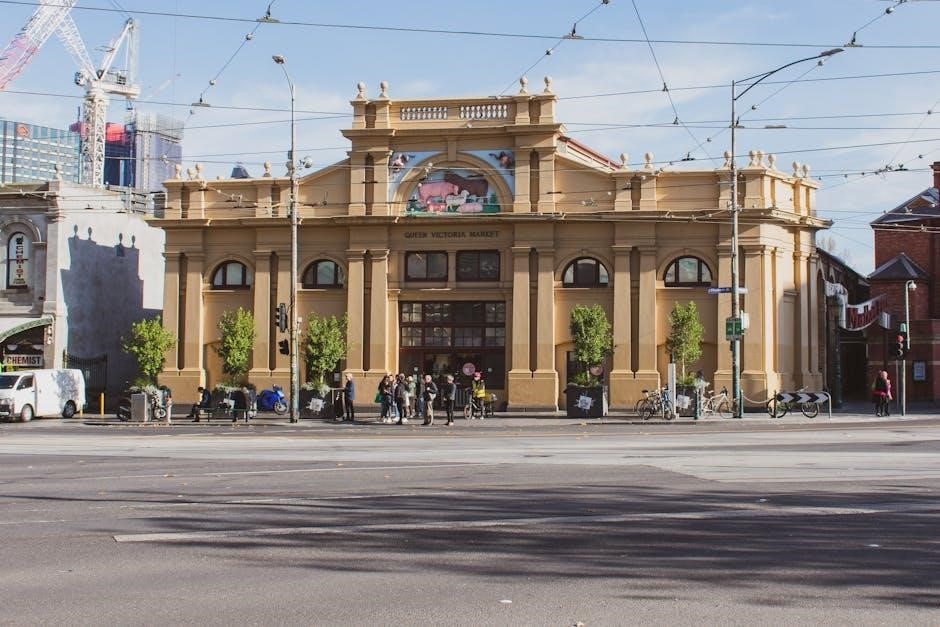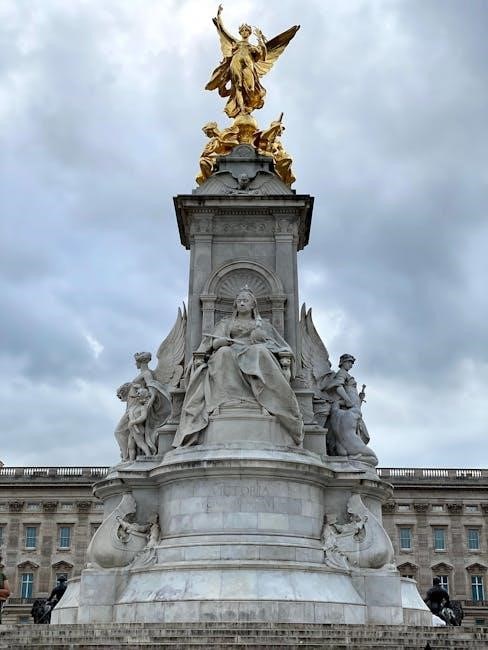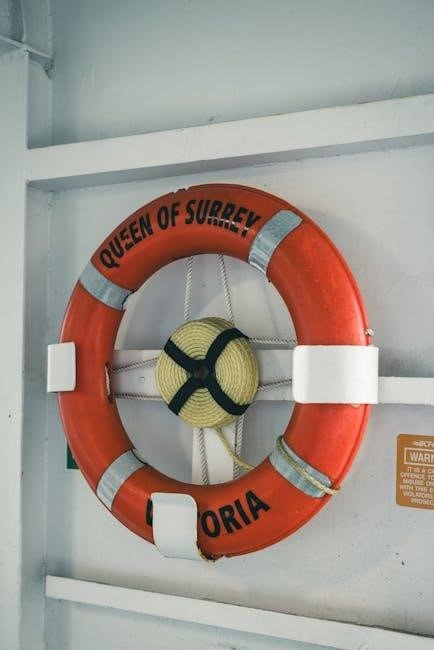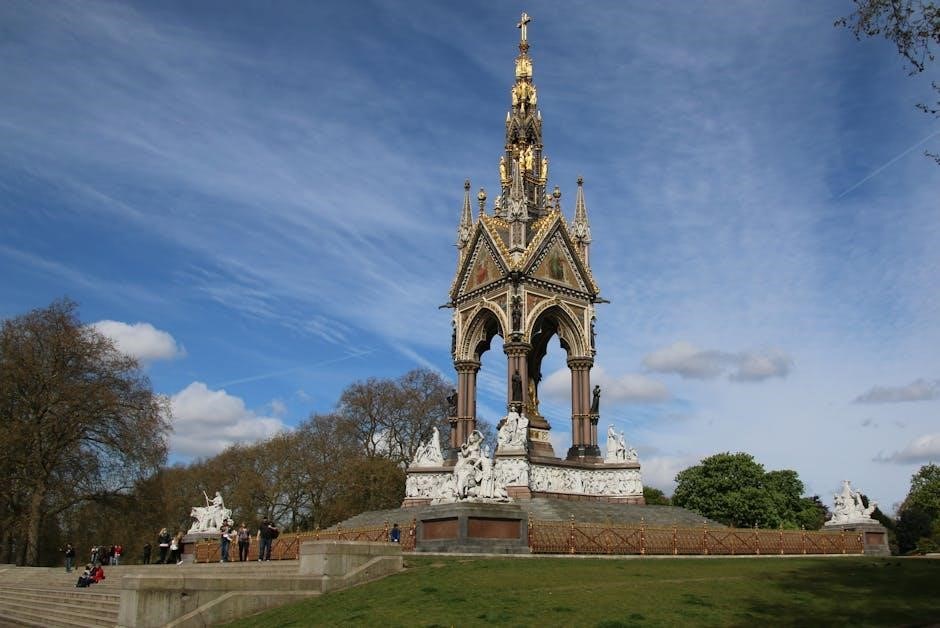Queen Victoria’s diaries, spanning from 1832 to 1840, offer a personal and historical glimpse into her life, including her marriage to Prince Albert and royal duties.
Overview of the Diaries and Their Historical Significance
Queen Victoria’s diaries are a remarkable historical resource, offering intimate insights into her life, reign, and personal experiences. Spanning over a century, the diaries include 141 volumes, with 43,765 pages, providing a detailed account of her coronation, marriage to Prince Albert, and significant events like the Diamond Jubilee. Edited by her daughter Princess Beatrice, the diaries represent about a third of the original content, preserving her voice while respecting her privacy. The digitization project, “Queen Victoria’s Journals,” makes these records accessible online, featuring high-resolution images and transcriptions. This collection is invaluable for understanding the Victorian era, royal life, and the emotional landscape of one of history’s most iconic monarchs.
Structure and Content of the Diaries
Queen Victoria’s diaries are contained in 111 large manuscript volumes, covering her life from July 1832 to February 1840. These volumes, edited by Princess Beatrice after her death, represent about a third of the original diaries. The entries detail her personal thoughts, royal duties, and significant events, such as her engagement to Prince Albert and their wedding. The diaries are rich in emotional depth, capturing her joy, love, and later grief. The digitized collection includes transcriptions and keyword searching, making the diaries accessible for historical research. This structured record provides a unique window into the life of a monarch, blending private reflections with public responsibilities.
The Wedding of Queen Victoria and Prince Albert
Queen Victoria married Prince Albert on February 10, 1840, at St. James Palace, marking a grand and significant event in her life and reign, documented in her diaries.
The Diary Entry from February 10, 1840
Queen Victoria’s diary entry from February 10, 1840, captures her profound joy and exhaustion following her wedding to Prince Albert. She describes the grand ceremony at St. James Palace, her emotions, and the whirlwind of events. Victoria writes about feeling overwhelmed but deeply in love, highlighting the personal and historical significance of the day. The entry reflects her intimate feelings and the beginning of a lifelong partnership with Albert, offering a glimpse into their relationship and the royal life they were building together. This diary entry remains a cherished and significant document in historical records.
Details of the Wedding Ceremony and Its Impact
Queen Victoria’s wedding to Prince Albert on February 10, 1840, was a grand and elaborate ceremony at St. James Palace in London. Victoria wore a white wedding dress adorned with orange blossoms, setting a trend for future brides. The event was marked by traditional rituals and personal touches, such as Victoria’s decision not to promise to “obey” Albert in her vows, reflecting her strong personality. The marriage solidified alliances between British and German royal families and marked the beginning of a partnership that deeply influenced Victoria’s reign. The ceremony was greeted with widespread public celebration, cementing the couple’s popularity and shaping the Victorian era’s cultural landscape.

Queen Victoria’s Relationship with Prince Albert
Queen Victoria and Prince Albert shared a deep bond, marked by mutual respect and affection, which significantly influenced her reign and personal life.
Early Meetings and Engagement
Queen Victoria first met Prince Albert in 1836, though their formal introduction occurred in 1839. Their early interactions were marked by mutual curiosity and respect. Victoria, impressed by Albert’s charming demeanor, documented her growing affection in her diaries. The couple’s engagement was formalized in October 1839, with Victoria proposing to Albert at Windsor Castle. This pivotal moment reflected Victoria’s strong will and emotional connection to Albert, setting the stage for their union and future partnership in both marriage and monarchy.
Personal Letters and Diary Entries About Albert

Queen Victoria’s personal letters and diary entries reveal a deep emotional bond with Prince Albert. Her writings express admiration for his character, intelligence, and beauty, reflecting a passionate and loving partnership; Victoria often described Albert as her “dearest dear” and highlighted his supportive role in her life. Their correspondence, filled with affectionate language, underscores mutual respect and devotion. These intimate records provide insight into their relationship, showcasing Victoria’s reliance on Albert as both a husband and confidant. The diary entries and letters remain a testament to their enduring love and collaboration during their time together.

The Digitization of Queen Victoria’s Diaries
The “Queen Victoria’s Journals” online project provides digital images and transcriptions of her diaries, covering 1832 to 1840, made accessible through a collaboration with the Royal Archives and ProQuest.
The “Queen Victoria’s Journals” Online Project
The “Queen Victoria’s Journals” online project, launched in 2012, digitizes the Queen’s diaries from 1832 to 1840. It features high-resolution images of each page, full transcriptions, and keyword search functionality; This initiative, a collaboration between the Royal Archives, Bodleian Libraries, and ProQuest, aims to preserve and make accessible Queen Victoria’s personal writings. The project coincided with Queen Elizabeth II’s Diamond Jubilee, celebrating Victoria’s enduring legacy. Users can explore detailed accounts of her life, including her engagement, wedding to Prince Albert, and early reign. This digital archive provides scholars and enthusiasts unparalleled insight into the Victorian era through the Queen’s own voice.
Transcriptions and Keyword Searching Features
The digitized diaries include meticulous transcriptions, enabling users to read and search Queen Victoria’s entries effortlessly. The keyword search feature allows researchers to find specific events, names, or themes quickly. This functionality highlights the emotional depth of Victoria’s writings, particularly her devotion to Prince Albert and her grief after his death. The transcriptions preserve the original language and tone, offering a genuine connection to the past. This feature-rich platform enhances accessibility, making the diaries a valuable resource for historical studies and personal exploration of the Victorian era.
Key Events in Queen Victoria’s Life
Queen Victoria’s life was marked by her coronation, marriage to Prince Albert, the birth of nine children, and the Diamond Jubilee celebrating her 60-year reign.
Coronation and Reign
Queen Victoria’s reign began with her coronation on June 28, 1838, marking the start of the Victorian era. At just 18, she ascended to the throne, bringing a youthful energy to the monarchy. Her coronation was a grand affair, attended by nobility and citizens alike, symbolizing the beginning of a new era. Victoria’s reign was characterized by significant political, cultural, and industrial transformations. She married Prince Albert in 1840, and together they had nine children, strengthening European royal ties. The Industrial Revolution flourished under her rule, and the British Empire expanded globally. Her reign, spanning 63 years, ended with her Diamond Jubilee in 1897, cementing her legacy as one of history’s most influential monarchs.
Marriage to Prince Albert and Family Life
Queen Victoria’s marriage to Prince Albert on February 10, 1840, marked a pivotal moment in her life, deeply captured in her diaries. The union, despite initial familial resistance, brought immense joy and stability. Victoria often expressed her adoration for Albert, describing him as her “beautiful Albert” and highlighting his intellectual and emotional support. Together, they had nine children, with Victoria documenting each pregnancy and childbirth in her journals. Their marriage symbolized a harmonious partnership, blending personal affection with royal duty. The couple’s family life was central to Victoria’s identity, shaping her reign and leaving a lasting legacy in British history.
Emotional and Psychological Aspects of the Diaries
Queen Victoria’s diaries reveal her deep emotional spectrum, from the joy of her marriage to Prince Albert to the profound grief following his death, shaping her psyche.

Expression of Joy and Love
Queen Victoria’s diaries vividly capture her profound joy and love, particularly in her relationship with Prince Albert. Her entries often express deep affection, describing Albert as “beautiful” and recounting moments of tenderness. The wedding day entry radiates happiness, detailing her emotions and the elegance of the ceremony. Their bond is evident in her writings, showcasing a partnership filled with mutual admiration and love. These expressions provide a heartfelt glimpse into Victoria’s personal life, revealing a monarch deeply in love and fulfilled by her marriage. The diaries highlight the transformative impact of Albert on her life, creating a legacy of devotion.

Grief and Loss After Albert’s Death
Queen Victoria’s diaries reveal her profound grief following Prince Albert’s death in 1861. Her entries express deep emotional pain, describing a void left by his absence. Victoria’s writings reflect her reliance on Albert, both personally and as a partner in rule. The diaries document her prolonged mourning, which lasted decades, and her struggle to adapt to life without him. The loss reshaped her reign, as she withdrew from public life, earning her the nickname “The Widow of Windsor.” Her diaries serve as a poignant record of her enduring sorrow, showcasing the depth of their bond and her inability to reconcile life without Albert.

Legacy and Cultural Impact
Queen Victoria’s diaries have profoundly influenced Victorian literature and society, offering insights into her reign and personal life. Her relationship with Prince Albert inspired numerous books, films, and series, cementing her cultural significance and enduring legacy.
Influence on Victorian Literature and Society
Queen Victoria’s diaries have had a profound impact on Victorian literature and society, providing a unique window into the Queen’s personal life and reign; Her detailed entries, spanning from 1832 to 1840, reveal her thoughts on marriage, motherhood, and governance, offering insights into the social and cultural dynamics of the era. The diaries have inspired numerous literary works, films, and adaptations, shaping public perception of the Victorian period. Prince Albert’s influence on Victoria is evident throughout, highlighting his role in shaping her views and decisions. The digitization of these journals has further amplified their cultural significance, making them accessible to researchers and the public alike, ensuring their enduring legacy in historical and literary studies.
Modern Interpretations and Adaptations
Queen Victoria’s diaries have inspired modern adaptations, including films and TV series like “The Young Victoria” and “Victoria,” which highlight her relationship with Prince Albert. The digitization of her journals has made her writings accessible to a global audience, sparking new scholarly and public interest. These adaptations often emphasize Victoria’s emotional depth, particularly her love for Albert and her grief after his death. Modern interpretations also explore the diaries’ historical context, offering fresh perspectives on her reign and legacy. The intimate nature of her writings continues to captivate audiences, bridging the past with contemporary understanding of Victorian history and culture.
